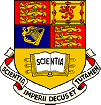
 |
|
News Page |

March 2000 |
This month's news stories:Student Papers HighlightedStudents attend ERCA2000 Space Weather Study Gets OK |
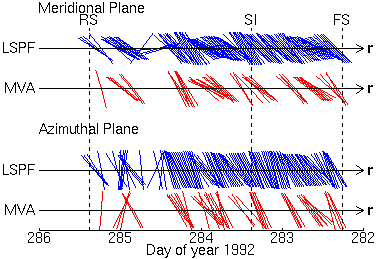 Students' work highlighted in Geophysical Research Letters
Students' work highlighted in Geophysical Research LettersIn two consecutive issues of the prestigious Geophysical Research Letters, on 1 and 15 March, papers published by Dorian Clack (with his supervisor, Bob Forsyth and in collaboration with Malcolm Dunlop) and Rob Wilson (with his supervisor Michele Dougherty) have received the honour of being highlighted as particularly important contributions to their subjects.
Dorian, Bob and Malcolm reported on observations made by the magnetometer on Ulysses of the magnetic field structure within Corotating Interaction Regions (CIRs), the vast structures in the heliosphere which result from the collision of fast and slow solar wind streams. Their results represent the first systematic study of the large-scale, three-dimensional magnetic orientation of these CIRs, and show that the orientation of the structures is different in the northern and southern regions of the heliosphere.
The figure shows the results of a 3-hour sliding window planar analysis of magnetic field data from a CIR observed by Ulysses on days 282 - 285 of 1992. The analysis was performed using both least squares planar fit (LSPF) and minimum variance analysis (MVA) techniques. The resulting planar structures are shown projected onto the meridional and azimuthal planes, tilted with respect to the anti-sunward radial vector r. Time runs from right to left. (See D. Clack, R. J. Forsyth and M. W. Dunlop, Ulysses observations of the magnetic field structure within CIRs, Geophys. Res. Lett. Vol. 27 , No. 5 , p. 625, 2000)
The paper by Rob and Michele reported on evidence provided by the Galileo Jupiter Orbiter mission of Ultra Low Frequency (ULF) waves within Jupiter's middle magnetosphere. Their results show that these waves are prevalent over the nightside magnetosphere (a region around Jupiter that had not been explored before Galileo) and, when combined with the earlier work on the dayside of Jupiter's magnetosphere, suggest that these waves are a global phenomenon. Their results have important implications for the dynamics of the jovian magnetosphere which can now be followed up to review and revise previous models of ULF wave generation.
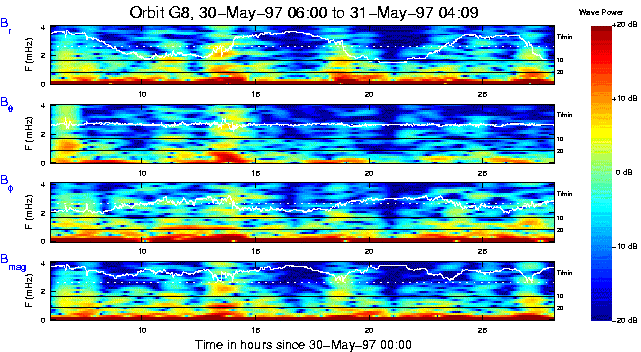
The above figure shows dynamic spectra of the magnetometer data taken from Galileo orbit G8. The spectra are overlain with the magnetic field (in white, and on an arbitrary vertical scale) which was used to calculate the spectra. The dotted white line indicates the zero line for the field. The scale on the right axis is of period in minutes, with black horizontal lines being overlaid to aid identification of features. Twenty two hours of data are shown here, corresponding to just over 2 Jovian days. (See R.J. Wilson and M.K. Dougherty, Evidence Provided by Galileo of Ultra Low Frequency Waves Within Jupiter's Middle Magnetosphere, Geophys. Res. Lett. Vol. 27 , No. 6 , p. 835, 2000)
André Balogh 20th March 2000
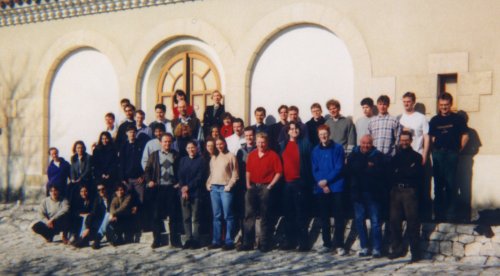 SPAT students attend ERCA2000
SPAT students attend ERCA2000Early this year 5 PhD students from SPAT (Ashley Tomsett, Paul Green, Grant Matthews, Giuseppe Pettinato and Ruben Rodriguez-De Leon) were among 40 young scientists from across Europe who attended the prestigious European Research Course on Atmospheres (ERCA) in Grenoble, France. The course, held annually at the Joseph Fourier University, is an international high level integrated course centered on the Physics and Chemistry of the atmosphere of the Earth, its climate system, climate change and the Physics and Chemistry of the atmosphere of other solar system objects. It is designed as a multidisciplinary course with a wide diversity of subject matter and gives a rare opportunity for the participants to broaden their horizons in the field of atmospheric science.
The first four weeks of the course were spent in Grenoble, where invited lecturer's from across Europe and beyond, including the Nobel Laureate Paul Crutzen, gave a series of specialist lectures in their own areas of expertise. The lectures covered the basic physics and chemistry of the Earth's atmosphere, then moved on to more specialist areas ranging from paleoclimate through to astrobiology and planetology, with topics such as outdoor and indoor air pollution, ice core analysis and climate change in-between. The participants from SPAT also presented their own research at the weekly poster presentations.
The final four days of the course were spent at the "Observatoire de Haute-Provence" (OHP) in Provence, near Forcalquier. Here the Service d'Aéronomie of CNRS has extensive experimental facilities for atmospheric measurements and instruments such as temperature, wind, and ozone lidars, a Michelson Interferometer, and a balloon sounding were presented in lectures and demonstrated.
The students from SPAT thoroughly enjoyed the course, both from an academic point of view and the opportunity it gave them to meet and socialise with other PhD students from across Europe, and highly recommend the course to anyone who has the opportunity to attend.
Funding for A. Tomsett was provided by the Environment Agency.
Ashley Tomsett 24th March 2000
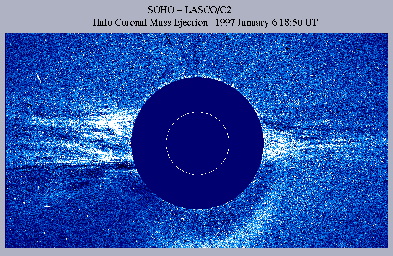 Space Weather Study Gets OK
Space Weather Study Gets OKSpace Weather can be broadly defined as the prediction and monitoring of conditions in near-Earth space. While the space environment is usually rather benign, there are occasions when solar phenomena lead to adverse and hostile conditions. At these times, technical systems in space are subject to possible damage or loss. Examples include satellite charging due to energetic ("killer") electrons, rapid loss of satellite altitude due to atmospheric expansion, disruption of communications due to disturbed ionospheric conditions etc. These effects have led to an increasing awareness of the need to develop national and international programmes to both predict the onset of hazardous conditions, and to provide a scientific underpinning that addresses the physical processes involved.
On March 10, the European Space Agency (ESA) accepted two contracts that will study the possibility of ESA developing a major space weather initiative. The Space and Atmospheric Physics group will be involved in a study lead by ALCATEL, that also involves UK groups from British Antarctic Survey and Mullard Space Science Lab, as well as teams from Sweden, France and Germany. Prof Peter Cargill will lead the IC effort which will focus on the possibility of tracking geoeffective solar events through interplanetary space from the Sun to the Earth, and in predicting the geoeffectiveness of such events using a small monitor Sunward of the Earth.
Peter Cargill 13th March 2000
View Last month's news, older news or return to Space and Atmospheric Physics home page